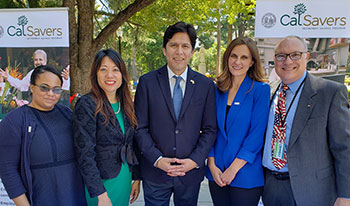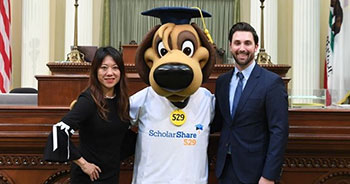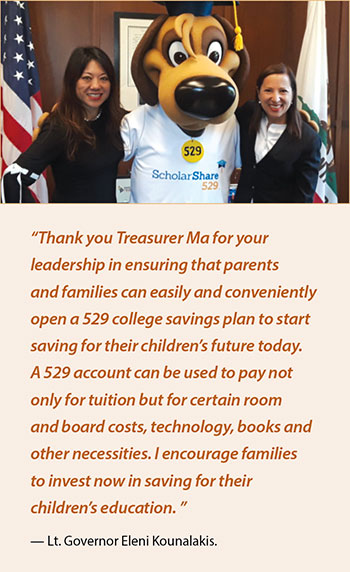Half-Year Highlights 2019 Articles
Newsletter Downloads
- August 2019
HTML version, PDF version - Half-Year Highlights: Jan - Jun 2019
HTML version, PDF version - July 2019
HTML version, PDF version - May 2019
HTML version, PDF version - April 2019
HTML version, PDF version - March 2019
HTML version, PDF version - February 2019
HTML version, PDF version
Nurturing Financing
January - June 2019

Treasurer Ma serves as the agent for the sale of all State bonds. This past spring the STO sold $7.4 billion in bonds, including:
- $5.15 billion in voter-approved general obligation bonds, including $1.47 billion for new projects and $3.68 in refunding bonds. The refunding of bonds will save the State’s General Fund $1.42 billion over the next 19 years, or $1.1 billion on a present value basis.
- $653.06 million in revenue bonds for The Regents of the University of California. This included
- $153.06 million for new projects and $500 million in refunding bonds.
- $299.59 million in Department of Water Resources Central Valley Project water system revenue bonds.
- $83.92 million in IBank Safe Drinking Water State Revolving Fund revenue bonds.
- $1.06 billion in conduit revenue bonds for various conduit financing authorities, including those chaired by the State Treasurer.
- $20.79 million in lease revenue bonds for the State Public Works Board.

University of California, UCLA campus
The STO oversees an investment portfolio that as of June 30, 2019 was slightly more than $105 billion, of which more than $24 billion were local government funds.
Through the Pooled Money Investment Account (PMIA), the State Treasurer and her team manages and prudently invests the state’s idle surplus funds. The PMIA total broke $100 billion for the first time in April.
The PMIA has three primary sources of funds: the State General Fund; surplus funds held by State agencies; and monies deposited by more than 2,300 cities, counties and other entities into the Local Agency Investment Fund.
Within the State’s investment portfolio is a little-known, but powerful program called the Time Deposit Program that is designed to place state deposits in community banks that are headquartered in California. These are the same banks that provide loans to small businesses to help them grow and employ more Californians. This program presently has funds on deposit with about 70 of California’s independent banks and credit unions. At the end of the June 2019, the STO had close to $5 billion invested in California banks.

At the December launch of the CalABLE program, which now provides eligible Californians with the ability to save more money in disability-related tax-advantaged investments.
The STO also manages three savings programs – CalABLE, CalSavers, and ScholarShare:
The CalABLE Savings Plan opened to the public on December 18, 2018. The program gives Californians and out-of-state residents the ability to save for disability-related expenses by putting money in tax-advantaged investments, while protecting their eligibility for public benefits programs. As of June 30, 2019, the STO:
- Facilitated the opening of 1,548 accounts with more than $5.1 million in assets under management.
- Successfully encouraged the U.S. Department of Housing and Urban Development to release its guidance on how it would view funds in an Achieving Better Life Experiences (ABLE) account as they relate to the housing subsidies and benefits HUD oversees. This long overdue guidance, expected since 2015, will result in greater consistency in the consideration of ABLE account holders for housing benefits.
- Provided testimony to the California Legislature’s Assembly Committee on Revenue and Taxation in support of AB 736, sponsored by Treasurer Ma. AB 736 seeks conformity of California tax code with a new part of the federal tax code, allowing for tax-free and penalty-free treatment of money rolled over from a 529 college savings account, to a CalABLE account.
- Fielded more than 1,420 CalABLE customer support line calls and experienced nearly 14,000 total website visits.
- Conducted more than 50 CalABLE presentations to individuals, advocacy groups and service providers.

Treasurer Fiona Ma, former state Senator Kevin de Leόn, and CalSavers Executive Director Kate Selenski, flanked by staff members Akilah Jones and Mark DeSio, at the formal launch of the retirement savings program for private sector workers in July.
The CalSavers Retirement Savings Program will provide a path to retirement security for the 7.5 million hard working Californians who currently lack access to a workplace retirement account with no cost to taxpayers or employers. In addition, these accounts are portable and belong to the employee. First launched in November 2018 with a pilot program and then to all eligible employers on July 1, 2019, CalSavers provides employees access to a retirement savings program without the administrative complexities, fees, or fiduciary liabilities of existing options for employers. Any employer with at least five employees who doesn’t already offer a workplace retirement savings vehicle will be required to either begin offering one via the private market or provide their employees access to CalSavers. CalSavers’ operation will be funded solely through saver fees. Between November 2018 and June 30, 2019, the STO:
- Completed a successful pilot for CalSavers in which the retirement savings program recorded nearly 1,700 funded accounts, with another 1,500 enrollments awaiting their first payroll cycle, with 60 participating employers that reflect the diversity of the state (by geography, industry, size, and employee composition).
- Launched a bilingual mobile app for CalSavers, making California the first among peer states to launch an app of any kind.
- Presented information about CalSavers at more than 45 community events throughout California while our non-profit partners presented at another 55 community events.

With Assembly Majority Leader Ian Calderon and Diploma Dog at the State Capitol in May.

The ScholarShare Investment Board sets investment policies and oversees all activities of ScholarShare, the State’s 529 college savings plan. The program enables Californians to save for college by putting money in tax-advantaged investments. After-tax contributions allow earnings to grow tax-deferred. Disbursements, when used for tuition and other qualified expenses, are federal and state tax-free. As of June 30, 2019, the STO:
- Facilitated the opening of more than 13,500 new ScholarShare 529 college savings accounts and recorded nearly $410 million in new contributions. Also distributed more than $184 million to families to pay for qualified higher education expenses. More than $9.35 billion has been invested by families in more than 325,000 ScholarShare 529 accounts.
- Distributed $305,000 to 20 schools across the state as part of ScholarShare 529’s Scholar Dollars program. The winning schools will use the awards to support their extracurricular and enrichment programs. In 2019, more than 377 eligible K-8 public and charter schools competed in the Scholar Dollar program.
- Partnered with Assembly Majority Leader Ian Calderon on AB 211, which seeks to provide California families with a tax deduction for contributions of up to $5,000 (single) or $10,000 (joint) to a ScholarShare 529 account for account holders with $75,000 adjusted gross income (AGI) annually, or families who earn $150,000 AGI annually. California is currently one of only seven states with a state income tax that does not provide a state tax incentive for contributions to their 529 college savings plan, thus luring California taxpayers to invest in other state’s college savings plans.
- Partnered with 16 new employers in 2019, which include the City of Buena Park and the Foundation of California Community Colleges, to offer ScholarShare 529 to their employees and attended more than 114 employer outreach activities.
Protecting the public’s money is a compulsory duty of the Treasurer. The following were other notable STO investments made toward health care and schools during the first six months of 2019:
Health Care
- Disbursed approximately $38.5 million through the California Health Facilities Financing Authority’s (CHFFA) Children’s Hospital Program, which was funded via general obligation bonds approved by voters.
- Disbursed approximately $18 million in capital funding through CHFFA’s Mental Health Wellness Grant Programs to San Bernardino County for a total of 88 beds – 48 in Crisis Residential Treatment (CRT) and 40 in the Crisis Stabilization Unit (CSU). Slightly more than $3 million in capital funding went to Fresno County, which added 16 CSU beds. Marin County received $600,000 in capital funding to add five CSU beds. Three counties (Fresno, Marin and Merced) completed their projects and added 37 CRT and CSU beds.
- Approved disbursements through CHFFA for $1.3 million in personnel funding to Los Angeles, Mendocino, and Santa Barbara counties for their mobile crisis support teams.
- Approved four grant awards, totaling approximately $2 million, from CHFFA’s Investment in Mental Health Wellness Grant Program for Children and Youth to Marin, Monterey, Sacramento, and Santa Cruz counties. These grants will expand children and youth mental health crisis intervention services by developing a total of six mobile crisis support teams, consisting of six vehicles and 16 full-time personnel.
- Approved three CHFFA bond issuances for the following:
- Tarzana Treatment Centers, Inc. – $13.5 million in tax-exempt and taxable private placement bonds for renovation and construction of multiple projects as well as to refinance outstanding debt and reimburse previously expended construction costs.
- Children’s Hospital of Orange County – $117 million in tax-exempt bonds to refinance all or a portion of outstanding CHFFA bonds to reduce the hospital’s interest exposure.
- City of Hope – $370 million in tax-exempt bonds to construct a new 350,000-square-foot outpatient clinic, a new parking structure, and an expansion of housing services for patients undergoing long-term treatment and their families.

Rendering of Children’s Hospital of Orange County.
Schools
- Approved 19 loans to schools totaling $4.65 million through the California School Finance Authority’s (CSFA) revolving loan fund program. By implementing an innovative new disbursement process, this program saved $150,000 from what could have been defaulted loan funds. CSFA also issued $47.7 million in bonds and $25 million in Revenue Anticipation Notes for charter schools.
- Disbursed $63,476,820 in grants to 400 schools serving 180,645 students through the Charter School Facilities Grant Program administered by CSFA.
- Determined that eight projects with estimated costs totaling more than $140 million in CSFA’s Charter School Facilities Program were financially sound for funding and award.





